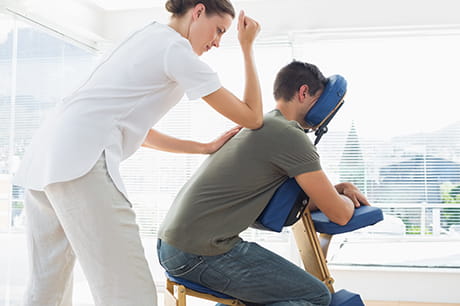There’s the rub: The benefits of therapeutic massage
Whether an injury needs healing, pain needs taming or muscles need stretching, medical massage can be key to your recovery.
When you think “massage,” does it conjure images of candles, fragrant oil and ethereal music (and utter, bone-melting relaxation)? For a massage at a day spa, that’s accurate. But in a different setting, massage is more than just a luxury. A medical massage may play a crucial part in a clinical recovery regimen after injury or surgery.
How does therapeutic massage differ from relaxation massage?
While a spa massage is something you might schedule on a weekend — and on a whim — therapeutic massage, also known as “medical massage,” is a prescribed component of physical or occupational therapy.
“Therapeutic massage and other manual techniques are coupled with active stretching and strengthening for the most successful, lasting results,” says Ashley Mundenar, who holds a doctorate in physical therapy and is an orthopaedic clinical specialist at the therapy clinic at Geisinger Healthplex CenterPoint in Pittston, Pa.
What are the benefits of therapeutic massage?
This type of therapy has three main goals, according to Dr. Mundenar, who is specialty-certified in orthopaedics.
Helping your body heal
The first goal is healing. “Blood flow is required for adequate healing — manual therapy and massage can speed the healing process up by enhancing blood flow to the area of injury or pain,” says Dr. Mundenar. Your blood carries oxygen, which controls infection and inflammation. It also spurs growth of collagen and new capillaries.
Lessening your pain
Pain management is the next aim. “There are times, especially in acute injury, that massage and hands-on approaches for pain management are all a patient can tolerate. Even light touch or lymphatic massage can help change the way pain is perceived and manage swelling in the area,” she says.
And despite what you may think, massage doesn’t have to be hard or painful to be effective. Tell your therapist what level of pressure you prefer, from light to medium to firm. They might be able to increase pressure over time as your pain lessens.
Finding your flexibility
The third goal of medical massage? Flexibility. Patients with chronic injuries, or those whose movement has been limited for long periods, can benefit from massage and manual therapy to help mobilize:
- Joints
- Fascia (connective tissue)
- Muscles
- Soft tissue
Loosening up each component of your affected body part — whether it’s your shoulder, ankle, back or something else — aids in restoring its overall range of motion.
Reasons you might need therapeutic massage
Who’s a candidate for medical massage? People who:
- Just had surgery
- Have been immobilized for some time (for example, by a cast or sling)
- Have difficulty managing pain
- Have limited range of motion
You might also benefit from therapeutic massage if you have an injured leg that must be non-weight-bearing for several weeks, says Dr. Mundenar. When you don’t use a muscle, it atrophies, or gets smaller and weaker. By improving blood circulation, massage can encourage muscle growth.
Just one element in your recovery
If you do qualify for therapeutic massage, know that it’s not a long-term treatment. “The success of medical massage is limited. It’s often performed as a gateway to tolerating other forms of therapy that are much more beneficial and long-lasting,” says Dr. Mundenar.
Once you start being able to manage your pain, she says, “the key to success lies in the activities and actions that follow. Consistent, controlled movements within pain-free ranges of motion will improve strength, balance, flexibility and function.”
So, if an injury or surgery leads to pain and stiffness, ask your doctor whether therapeutic massage might be right for you. Because in some situations, when the pressure’s on, it can bring much-needed relief.
Next steps:
What is pandemic foot and how can you avoid it?
What’s causing your hand and wrist pain?
How you can prevent work injuries





